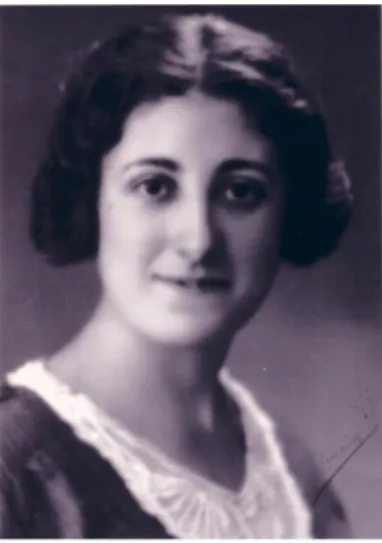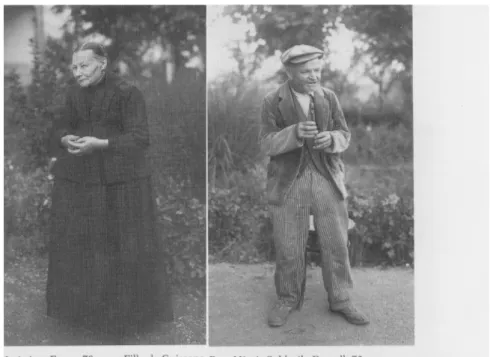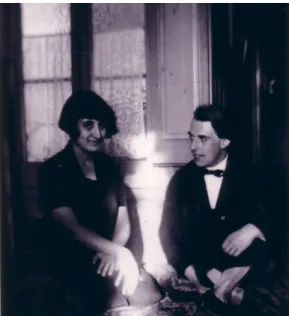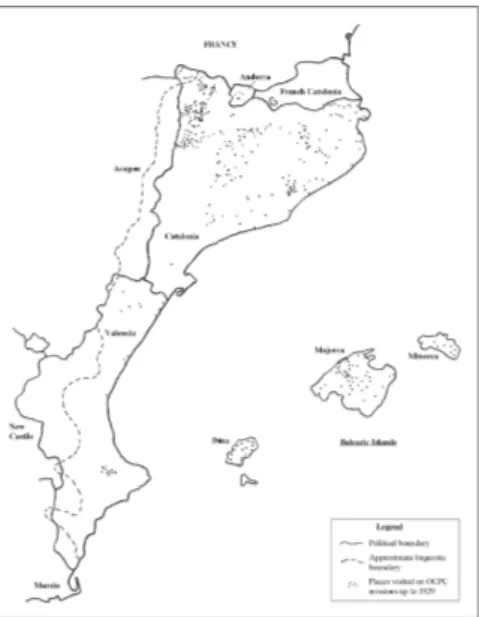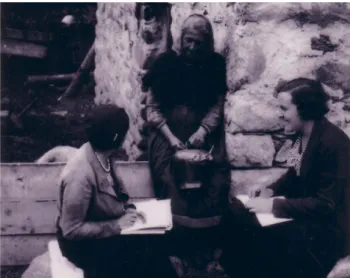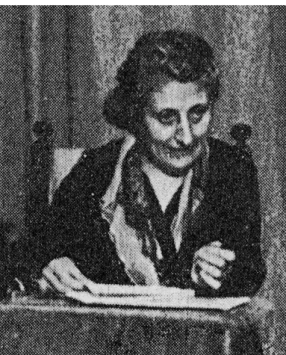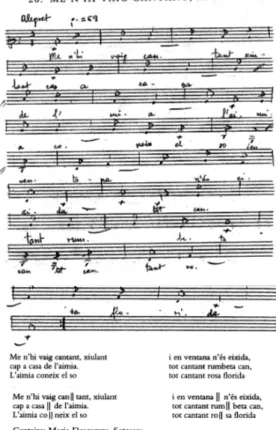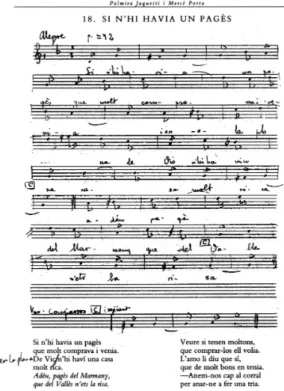FOlk sONg COlleCtOr (1895-1963)
Simon Furey*Abstract
Palmira Jaquetti was one of the most important folk song collectors of the great Catalan project, the Obra del cançoner popular de Catalunya, but remains little-known outside Catalonia. In her period of field research in the 1920s and 1930s she claimed to have collected around 10,000 songs, mainly in the foothills of the Pyrenees. A woman of great intellect, she achieved academic recognition and distinction in spite of being disadvantaged by poor health, a runaway husband and the dire socio-political situation of women in Spain in the years leading up to the Civil War and afterwards. This article examines her claims and her achievements, and concludes that Jaquetti deserves much wider recognition and acknowledgement as one of the handful of truly great 20th-century European folk song collectors that includes Sharp and Bartók.
Resumo
Palmira Jaquetti foi uma das mais importantes colectoras de canções tradicionais que participaram no grande projecto catalão denominado Obra del cançoner popular
de Catalunya, embora continue a ser muito pouco conhecida fora da Catalunha. Segundo ela, durante as recolhas que levou a cabo nos anos 20 e 30 do séc. XX, coligiu cerca de 10 000 canções, sobretudo nos contrafortes dos Pirinéus. Mulher de grande nível intelectual, conquistou o reconhecimento académico, não obstante várias desvantagens: saúde frágil, um marido que a abandonou, a péssima situação sociopolítica das mulheres nos anos que conduziram à Guerra Civil e nos que se lhe seguiram. Este artigo analisa as declarações e as realizações de Palmira Jaquetti e conclui que ela merece um reconhecimento muito maior, devendo ser considerada como pertencendo ao pequeno grupo dos mais importantes colectores de canções tradicionais europeias no séc. XX, que inclui Cecil Sharp e Béla Bartók.
* C/del Pi, 10. 17475 Sant Miquel de Fluvià (Girona). Catalunya. Spain. <simon.furey@
To appreciate the significance of Palmira Jaquetti, one must first understand that great work of folk-song collecting, the Obra del Cançoner Popular de Catalunya, or OCPC. Between 1921 and 1936 it attempted to collect every folk song of the Catalan-speaking lands, which include Catalonia, Valencia, parts of Aragon, the Balearic and Pitiusic islands in Spain, the Roussillon and parts of the Midi-Pyrenées in France and part of Sardinia. The aim was to eventually publish all of the songs in a huge song-book, or Cançoner.
The peak of folk song collecting in Europe took place in the later part of the nineteenth century and the early part of the twentieth, and was brought to a shuddering halt by the outbreak of the First World War. However, this war never reached Spain, so the effects of that cataclysm were not apparent. Instead, in 1936 civil war broke out with just as devastating consequences on the culture and traditions of the people, especially since Catalonia was on the losing side. In a sense, therefore, we may see the OCPC as a continuation of the 19th century collecting tradition, and indeed, its instruction manual1
for collecting was based on the Handbook of Folklore published in 1914 by the Folklore Society in England. It is also worth noting that 19th century song collection in Catalonia had a significant history; for example, Professor Manuel Milà i Fontanals was a contemporary of Francis J Child and published his own collection slightly earlier than Child, in 1882.
Palmira Jaquetti was one of the most important field workers for the OCPC, which altogether collected some 40,000 songs during its period of activity. Of those, Jaquetti herself claimed to have collected 10,000 between 1927 and 1934,2 a figure that many experienced folk-song collectors may
feel is exaggerated. However, the full story is even more extraordinary. Some details of Jaquetti’s life and work have been published by Roser Matheu, in her book Quatre dones catalanes (Four Catalan Women), but she says little or nothing about the song collecting. As Jaquetti herself put it, ruefully:
The diaries of the Cançoner were never published. External and collective factors well outside my small sphere of influence prevented it. Having stopped my work for the Obra del Cançoner Popular de Catalunya, I had to leave my file of songs, which contained some real gems, closed with the others and leave that whole great treasure lying silent.3
But, as we shall see, her collection was not lost. Almost the entire archive of the OCPC has been saved and is being published in annual extracts as OCPC Materials4 every year by Father Josep Massot i Muntaner at 1 J M Batista i Roca, Manual per a recerques d’etnografia de Catalunya, Barcelona, Arxiu
d’Etnografia i Folklore de Catalunya, 1922.
2 Roser Matheu, “La vida i l’art de Palmira Jaquetti (1895-1963)” in Quatre dones catalanes,
Barcelona, Fundació Salvador Vives Casajuana, 1972, p. 182.
3 Matheu, p.185.
Montserrat Abbey, near Barcelona. It is from his work we can now appreciate what a great folklorist Palmira Jaquetti was.
Figure 1: Palmira Jaquetti
Some biographical data to begin with will help the reader build a picture of Palmira Jaquetti i Isant and her work. She was born in La Seu d’Urgell in north Catalonia in 1895 and was the only surviving child of five. Her father was a construction worker who took jobs in Cuba to guarantee enough money for his family. He spent much of his free time improving his education; he was a nature lover, singer and keen excursionista, excursionism being then a common pastime for urbanites, who went hiking in the hills, meeting the local people and finding out about their customs and traditions. He had great intellectual ambitions for his daughter, and as an atheist he sent her to a private non-religious school in Barcelona, where she seems to have excelled at everything. On leaving school, and by selective examination, she got a teaching post in Vilafranca, where she continued to study for a state teaching qualification. She achieved this, coming top in her year, but was never awarded her proper qualification of Mestra Normal because of new laws restricting women under the Primo de Rivera dictatorship; she was, however, granted a mestratge de català, allowing her to teach Catalan language. Nothing daunted, having achieved her batxillerat, Jaquetti gained entry to the University of Barcelona to study philosophy and literature. She graduated “amb nota de Sobresalient i Premi extraordinari”, to translate which we might use the Latin term summa cum laude.5
Barcelona, Fundació C Rabell i Cibils, 1926-1929; vols IV et seq. ed. by Josep Massot i Muntaner, Barcelona, Abadia de Montserrat, 1993 - .
It was her time at Vilafranca that first brought Jaquetti to the attention of the OCPC, who awarded her a prize for the songs she had already collected in the surrounding district. She was subsequently invited, on 8 July 1925, to join the Obra del Cançoner Popular de Catalunya as a researcher. Whilst many of the collectors employed at that time by the OCPC were established folklorists attached to the Orfeó Català, the leading Catalan musical institution (Joan Amades and Higini Anglès fall into this category, for example), Palmira Jaquetti was fresh blood. The very next day6 she returned
to La Seu d’Urgell on her first OCPC mission, accompanied by an old friend, Maria Carbó i Soler. In a period of exactly 8 weeks they collected 637 songs with music. Their methods were straightforward: find the local parish priest to give a clue to where singers might be located, obtain introductions and then pay each informant a small fee for each song. In this case, of course, Jaquetti used her local roots to help her identify singers, and began with the local hospice for the poor (which housed a number of old people), and later proceeded to villages and hamlets in the vicinity. Recording of both words and music was done using pencil and paper. They had a camera to photograph their informants, and whoever the photographer was showed a gift for capturing their character. Examples of these photographs are given in OCPC Materials volume VI, and are shown in Figure 2.
Figure 2: Informants from La Seu d’Urgell
The diary that Jaquetti kept (and which is published in the same volume) gives a vivid account of her experiences throughout the period, of which the following is a sample:
We left to go and see a lady of middling age, of Froggy (sic – i.e. French!) appearance, whose speech was peppered with faint nasalities; she was tall and well-built, with a lively and ruddy face. She was doing the washing and would not let us sit down beside her; instead, she got up and we went and shut ourselves in a private courtyard. She wanted to hide from her husband, who some days earlier had forbidden her to sing, but she was determined to disobey him, convinced that she was not doing anything wrong, and was more understanding than her husband. She sang for us the only Catalan song she knew: it was one worth a hundred others.7
Or again, speaking of Pere Soldevila, shown in Figure 6:
Afterwards Pere sings, the strangest man in all the world. A beggar since birth, he has wandered across mountains and valleys. He knows everything, and the recognition of his wisdom is unanimous throughout the hospice. You can mention the most obscure village, with the most uncommon name, and he has been there. He knows all the people. He knows the number of houses and their layout. He has been through all of the French Midi and everywhere in the Pyrenees. Sometimes they gave him lodging and he earned ten rals a month (4 pesetas); One duro (5 pesetas) was the maximum he ever got. His mother taught him to beg and he is a fount of rhymes, folk hymns, recitations and songs. A dreadful singer, he has neither the voice nor the manner to give tonality to anything he sings. When we take the risk, the result is utter confusion. Yet his memory is terrifyingly good, and he says he knows 160 songs, 26 hymns and 40-odd rhymes; he details and classifies everything that he knows for us to collect, from the one from Sant Ferriol, or the one from Paraire or the dance from Falgars. Exactly as if he were still doing it for a living. He does not sing in tune, but his hands, eyes and feet express a music that is simply adorable. His body is like a gnarled branch, and he still digs the garden and waters the meadow. He plays a whistle and two other “instruments” that we have yet to see, When he sings, his eyes dance in his expressive face, and his mouth, which one could say resembles that of a nightjar, gaping open, shows the interior details as if unstitched right down to his belly. He still has two or three teeth, monolithic evocations of robustness. Like a cracked bell, he speaks with metallic inflexions, clear items now and then muddled with confused language. When he recites his rhymes, his eyes fill with malice and at times he cannot hold back the laughter and has to stop. They call him Peter the Hermit. He has been a shepherd, too, and he still remembers his shelter up in the mountains, where they made him work a lot. During his songs, he stops to tell us anecdotes of the places he names and the people he knows and their families, and when he is really excited his hand movements are not enough, so he shakes his legs, his head, and his whole body with the greatest expressiveness. He gives us a mixture of songs, fables and stories that are a real delight.
The keeping of a detailed diary was to become a feature of all Jaquetti’s missions. Each gives a glimpse of the people, how they lived and what part folk song played in their lives. She comments particularly that although the women sang while they worked, their songs were not about work; indeed, she found no songs about work.8 Her informants were largely women; this
seems to have been because the men were away from home working in the fields or elsewhere, but she certainly collected from men too.
The results of the mission were well received in Barcelona,9 and another
was organised for the following summer. From the various events, it would appear that Jaquetti was at this time studying at the University, so her OCPC work had to fit into her holidays. In 1926 the two ladies made what was to be for Jaquetti the first of many visits concentrating on the Pallars and Ribagorça valleys in north-western Catalonia. This is a mountainous area with scores of tiny villages and hamlets, many of which in her day were isolated and only accessible on foot or muleback. Between 2 July and 2 September, they collected 1216 songs with music. She commented in her diary that in the first six days they collected 162 songs, 50 on one day alone.
At the end of the year, and following her graduation, Palmira Jaquetti married Enric d’Aoust, her Belgian pen-friend, with whom she had corresponded during her studies; she was 32, he 21. The marriage was a disaster. Of course, we only have her side of the story, but Enric seems to have been an artistic ne’er-do-well who sponged off Palmira and her mother (her father had died a few years earlier). She, blinded with love, rejected the warnings of friends and family and proceeded to modify her behaviour to make him happy. In spite of the fact that he himself had a doctorate and became a professor of languages at Barcelona University, he was clearly daunted by her intellectual output of poetry and music, to say nothing of her song collecting, because she agreed to write nothing more than the diary for the OCPC missions. She tried to win him over by taking him on her song-collecting expeditions for the next few years, and he took to writing parts of the diary himself. But the marriage was not to last. After a painting trip Enric made to Majorca with friends and after he gone off with another woman, the couple formally separated. To add insult to injury, in 1934 Enric used the full weight of Spanish law to extract as much of her money as possible before he finally disappeared - and this when she was in hospital recovering from operations for the rheumatoid arthritis from which she had suffered since her teenage years in all four limbs. They finally divorced in 1951, after he had run away to Mexico, where he seems to have spent the rest of his life as an artist, painting and consorting with yet more women. Palmira never married again. Enric d’Aoust, however, left one final sting: because he was Belgian, she had acquired a French married name. By the
8 Materials, VI, p. 151. 9 Materials, V, p. 110.
laws of the time, Palmira Jaquetti d’Aoust was thereby prevented, as she says herself, from holding a professorship in Spain except in French - which she eventually did.
Figure 3: Palmira Jaquetti and Enric d’Aoust
Nevertheless, in spite of a difficult husband, in spite of rheumatoid arthritis, in spite of the lack of mechanical recording apparatus, in spite of the difficult terrain, much of which was only accessible on muleback and in spite of the lack of time, the song harvest she reaped in the north-west of Catalonia (and which is now held at Montserrat Abbey) was enormous, as Figure 4 shows:
Dates Partner Period Song Quantity
1926 Carbó 63 days 1216
1927 d’Aoust 72 days 1600
1928 d’Aoust 50 days 1354
1929 d’Aoust 66 days 1374
1931 Carbó 57 days 1111
Figure 4: Jaquetti’s Summer Song Collecting in North-West Catalonia
The quantity of songs they encountered was such that on at least one occasion, d’Aoust had to travel down to the nearest town to get more money sent from the OCPC in Barcelona to pay the singers. Furthermore, as
mentioned earlier, Jaquetti did not collect all of the songs she heard, but only took down the different ones. How she remembered or could distinguish differences among so many songs is a wonder; she does not explain her methods or criteria, and she certainly collected many different versions of the same songs.
The coverage was the most thorough of any OCPC researcher with the possible exception of Baltasar Samper in Majorca, as Figure 5 below attests. The locations visited by Jaquetti are shown as the dense cluster over the whole of north-western Catalonia.
Figure 5: OCPC Collection Sites in the Països Catalans 1922-1929
Yet as if that were not enough, she also collected in the Empordà / Costa Brava region during her Christmas holidays. The figures there are no less impressive, bearing in mind that the song collecting often involved visiting people in their homes over the Christmas festival, a time that tends to be reserved for families.
Dates Partner Period Song Quantity
1927 (Jan) Carbó 9 days 160
1927 (Dec) d’Aoust 4 days 58
1928/9 d’Aoust 11 days 174
1929 d’Aoust 6 days 107
Jaquetti’s diaries reveal something of the problems she faced. One woman in L’Estartit invited the couple back to her house for supper, promising to sing for them afterwards. At the end of the evening, the woman apparently sang very few songs, and these very badly, after which she demanded money not only for the songs but also for the inconvenience. The visit ended in unseemly haggling until a compromise was reached.
Apart from using her diaries to record her joy and disappointment at each discovery, Jaquetti also describes the scenery and the people. Early on the same trip that took her to L’Estartit, she describes a fellow-passenger on the bus to Verges:
The bus did not hang about, and we were jolted around horribly, jammed up against a peasant with a black nose, who was smoking happily on a stinking pipe. The peasant was thoroughly enjoying it; he was smiling, and from the right-hand corner of his mouth came black juice that dribbled down his week-old stubble, dripped on to his shirt and finally landed in his basket of meat.10
In spite of this discouraging encounter, the pair returned to Verges in the summer of 1930 instead of going to the mountains of the north-west. Here, on the flat coastal plain of the river Ter, Palmira and Enric collected 570 songs in just over three weeks. This was their last joint mission, and it seems likely that the choice of the Empordà as a search area was Enric’s, no doubt reacting against the years of spending his summers on muleback. The following year, 1931, when the couple had split up, Palmira returned to her favourite hunting-ground of Pallars with her old friend Maria Carbó.
Figure 7: Palmira Jaquetti, an Informant and Maria Carbó
According to the OCPC diary in Materials volume V, there seems to have been little collecting in 1932, and there is no explanation given. It may have something to do with the political uncertainty of the time. Certainly Palmira Jaquetti did not venture forth, although her reasons could have been personal ones, such as her arthritis. In the summer of 1933, however, and with a new partner, Mercè Porta i Pino, she collected 558 songs in the area around Camprodon. The same team went out the following summer on what was to be Jaquetti’s last official mission. This time they ventured over the French border, to Prats de Molló, and collected 543 songs in four weeks. We have evidence, therefore, that between 1925 and 1934 Palmira Jaquetti collected 9,462 songs in total, not far short of the 10,000 she claimed. Yet we still do not know whether we know everything. In the autumn of 1934 she was hospitalised and suffered the financial depredations of her husband. Catalonia was becoming unsafe by this time and the Civil War was yet to come. The OCPC project was abandoned in 1936. Nevertheless, this indomitable lady seems not to have given up. In the summer of 1940 she conducted her own field trip to the Vall d’Aran and its surrounding area, where she collected some dances, and she may have been active there again in 1941.11 Whether she collected more songs will not be revealed until
Massot publishes her final papers.
Jaquetti’s personal life continued to be eventful. Although brought up outside Christianity, she became a fervent Catholic, which undoubtedly saved her career during the Franco years. She continued to teach languages and literature at university level, to publish poetry and music and to win prizes for literature and the arts. However, two accidents left her with a permanent limp and a paralysed right arm. She was killed while a passenger in a car accident in 1963.
Although she had a fair amount of her own work published, Palmira Jaquetti does not seem to have produced much analysis of the folk songs she collected. She did produce one article on the subject which is appended to the notes of her first mission in 1925 to la Seu d’Urgell.12 Her arguments
are as follows.
She found no songs on the subject of work in the uplands where she was searching. People did sing at their work, but they adapted existing songs –often narrative ballads– to the task in hand. She argues that labouring people, fully engaged in the task at hand, have no time to think up songs, thus songs about ploughing or harvesting have very primitive (read: unimportant) words, while singers engaged in less physically strenuous tasks sing old favourite songs. Thus while tune and rhythm might vary, the words would be the least creative part of the song. This is not to equate lack of creativity with unimportance.
11 Materials, IV: 2, p. 494. 12 Materials, VI, pp. 151-153.
She rejects the idea of the long narrative ballads being created spontaneously by the people. First, she argues, there are no “people” but only individuals. Secondly, the singers in her experience take great care to preserve the old words, archaisms and all. Thirdly, the language is very different and reflects an unknown cultured origin for the ballads.
Jaquetti argues for four kinds of song, based on her field work. The first is the old narrative ballad, archaic in form, undiminished in popularity and adapted for use in everyday work. The second is the song of the people. This is created anonymously by ordinary people, largely for entertainment. The language is simpler, more repetitive and often joking. Excluding those of toil, such songs are used at weddings and wakes and other celebrations. The third category comprises written songs (by which I think we may assume she means what we would call broadsides) that have passed the popularity test and become part of the oral tradition. They are sung on any and every occasion. To these categories she adds a fourth: the songs of ceremony and ritual, such as La cançó de l’ós, used in the custom of Hunting the Bear.13
She concludes by saying that “the people” do not create songs; they merely preserve them and modify them for their own reasons. Hidden behind the people are the individual poets and musicians who create the songs.
What is striking to me about her views is how much they diverge from the older attitudes of Milà i Fontanals and the other 19th century collectors and how close they are to present-day thinking. This is because when examining the songs she considered the words, music and performance all together, as directed for collection by the Manual per a recerques d’etnografia de Catalunya. In her use of the information as a whole for analysis she was well ahead of her time; although Joan Amades recommended the same approach,14 we
cannot be sure when he began to use it and in any case his analysis often lacks rigour. Indeed, to this day there are folklorists who do not consider all three aspects in their studies. The pity is that no further analysis by Jaquetti has come to light.
13 Violet Alford, The Singing of the Travels, London, Parrish, 1956, p. 117.
14 Joan Amades, Folklore de Catalunya, 3rd ed., 3 vols, Barcelona, Selecta, 1982, Cançoner, pp.
Figure 8: Palmira Jaquetti Teaching
So what are we to make of this extraordinary woman? In her lifetime she was dogged by tragedy and the results of years of her work seemed to have been lost forever. Only now, from the information published by Josep Massot i Muntaner, can we begin to see her as she truly was in folk music terms: one of the greatest song collectors of all, far outstripping Sharp and Karpeles in their work in the Appalachians ten years earlier15 and matching
the collecting efforts of Bartók.16 Her work in north-western Catalonia is
exemplary in its thoroughness; one wonders what the harvest would have been if collectors of similar calibre had been available throughout Catalonia during the period of OCPC research.
Much of the foregoing will be found in my doctoral thesis,17 but I turn
now finally to a subject I raised on another occasion: the matter of musical dislocation.18 This is the phenomenon where the tune has one rhythm or
structure while the words have another. I noted it first in recordings of Catalan
15 English Folk Songs from the Southern Appalachians, coll. by Cecil J Sharp, ed. by Maud Karpeles,
London, Oxford University Press, 1932, repr. 1973, preface, pp. xii-xiii.
16 Béla Bartók, Studies in Ethnomusicology, ed. by Benjamin Suchoff, Lincoln, NE, University of
Nebraska, 1997, preface, p. ix.
17 Simon Furey, Harmony in Discord: An Analysis of Catalan Folk Song, unpublished PhD Thesis,
University of Sheffield, 2001.
18 Simon Furey, “An Oddity of Catalan Folk Songs and Ballads”, in The Flowering Thorn, Logan,
folk songs, specifically in the singing of Joan Manuel Serrat and the group Clau de Lluna. I then found instances in the collections of Palmira Jaquetti, and I asked the question if anyone else had come across this phenomenon. To date I have had no response from folklorists or ethnomusicologists, but I do have more evidence from two sources. The first is from my own experience, in that I now live for half the year in Catalonia and sing there. In my singing with others I have met this phenomenon as apparently a standard feature of Catalan singing style. Yet it rarely appears in books or anthologies; it appears to be a feature of live singing and as such seems to have been generally taken for granted by collectors and singers alike. The second source is the latest (2006) volume of Materials, volume XVI, which contains –as usual– another tranche of Palmira Jaquetti’s collected material. I have not yet had time to go through all of it, but have already encountered 6 examples of musical dislocation in the first 40 songs. Figure 9 shows one of these, and the edited text below (with caesurae added) highlights the dislocation.
The original text as written has alternating lines of 7 and 8 syllables. However, when sung, as will be seen from the music, each 7/8 pair becomes a 4/7/4 triplet, with the original line break ignored. Also, in every line the final syllable is stressed, in contravention of the normal spoken pronunciation, e.g. cantant is stressed can-TANT when spoken, but when sung here is CAN-tant, and casa (CA-sa) becomes ca-SA. This form of syllabic distortion is also found in Castilian songs, although I have not met the line break alterations found in Catalan songs. Interestingly, there is another song collected from the brother of Maria Descamps on the same field trip that has exactly the same dislocation from 7/8 to 4/7/4, yet it has a completely different tune: see Figure 10. Note the variations in the melody, too, in this last example.
Figure 10: A Further Dislocation Example
What this shows in my view is the exemplary care that Jaquetti took in her notation to ensure that the singing style was captured. And all this effort after days of travel on muleback from someone with a wrecked marriage, wrecked health, and who was even oppressed by the politics of the society in which she lived. Given such dedication as an example, it is perhaps no surprise that a group of present-day folk song researchers in Catalonia have adopted her name: the Equip de Recerca Palmira Jaquetti, whom I would like
to thank (in particular Salvador Rebés) for some of the material I have used in the preparation of this article.
References & Bibliography
obra del cançoner popular de Catalunya: Materials, vols I-III, ed. by Francesc Pujol and others, Barcelona, Fundació C Rabell i Cibils, 1926-1929; vols IV et seq. ed. by Josep Massot i Muntaner, Barcelona, Abadia de Montserrat, 1993 - .
alFord, Violet, The Singing of the Travels, London, Parrish, 1956.
aMades, Joan, Folklore de Catalunya, 3rd ed., 3 vols, Barcelona, Selecta, 1982.
Bartók, Béla, Studies in Ethnomusicology, ed. by Benjamin Suchoff, Lincoln, NE, University of
Nebraska, 1997.
Batistai roca, J. M., ed., Manual d’excursionisme, Barcelona, Barcino, 1927.
Batistai roca, J. M., ed., Manual per a recerques d’etnografia de Catalunya, Barcelona, Arxiu
d’Etnografia i Folklore de Catalunya, 1922.
equiPde recerca PalMira Jaquetti, “A l’entorn de Palmira Jaquetti i Isant”, Caramella, XIV
(gener-juny 2006): 64-66
Furey, Simon, Harmony in Discord: An Analysis of Catalan Folk Song, unpublished PhD Thesis,
University of Sheffield, 2001.
Furey, Simon, “An Oddity of Catalan Folk Songs and Ballads”, The Flowering Thorn, Logan, UT,
Utah State University Press, 2003.
Massoti Muntaner, Josep, Josep Crivillé i Bargalló, et al., El cançoner popular català (1841-1936,
Barcelona, Generalitat de Catalunya, Departament de Cultura, 2005
Matheu, Roser, “La vida i l’art de Palmira Jaquetti (1895-1963)” in Quatre dones catalanes,
Barcelona, Fundació Salvador Vives Casajuana, 1972.
sharP, Cecil J, English Folk Songs from the Southern Appalachians, ed. by Maud Karpeles, London,
